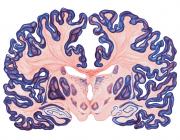Neurophysiological Correlates of Colour Induction on White Surfaces.
Publication Year
1992
Type
Journal Article
Abstract
Coloured light surrounding a white surface of about equal luminance makes the white surface appear illuminated with an unsaturated light of the complementary colour. In an attempt to discover the neurophysiological basis of such colour induction, we recorded from spectrally opponent cells of the parvocellular layers of the lateral geniculate nucleus (P-LGN) of anaesthetized macaques. Only cells with wide-band (W) spectral sensitivity in the short (S) or long wavelength (L) part of the spectrum (WS, WL) are excited by white spots of light centred on their receptive field. Cells with narrow-band (N) spectral sensitivity (NS, NL) and light-inhibited (LI) cells are inhibited by white light. Therefore, it is likely that the code for white is contained in a balanced excitation of the W cells. The effects of continuous illumination of remote surrounds with different wavelengths on the responses to achromatic light stimuli were investigated. Responses [on minus maintained discharge rate (MDR) or on-minus-off] were determined for white spots (1 - 3 degrees diameter) flashed on the receptive field centre, presented either alone or in the presence of an annular surround of equal luminance (inner diameter 5 degrees; outer diameter 20 degrees ). During red surround illumination the responses of WL cells to white spots tended to be reduced as were those of WS cells during blue surround illumination. Surround illumination with the opponent colour had more variable effects, neither WS nor WL cells showing a significant alteration of their mean response to white during surround illumination with opponent light. Response alterations were to a large extent due to changes in MDR, which increased in WS cells during blue surround illumination and in WL cells during red surround illumination. It is argued that the surround effects on centre responses are due to intraocular stray light rather than lateral connections in the retina. The surround effects also depended to some extent on the size of the test spot. LI cells and the very rare parvocellular panchromatic on-cells showed no chromatic response changes during coloured surround illumination. Inasmuch as the excitation of WS cells, either alone or in combination with NS cell activation, is involved in coding for green and blue, and that of WL cells, in combination with NL cell activation, is involved in coding for red and yellow in perception, the shift of excitation towards one or the other W cell group indicates relatively more red or green signals in the white response, consistent with and in the same direction as colour induction. In addition, the summed population response of WS and WL cells is decreased during surround illumination with any colour including white. This is related to brightness decrease during surround illumination in perception.
Journal
Eur J Neurosci
Volume
4
Pages
1079-1086
Date Published
10/1992
ISSN Number
1460-9568
Alternate Journal
Eur. J. Neurosci.
PMID
12106413

